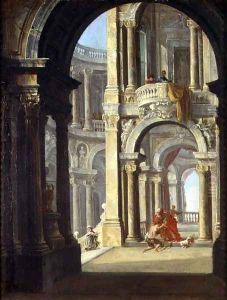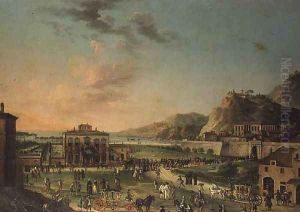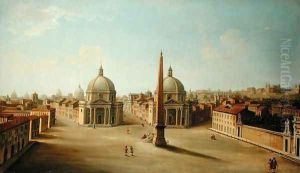Antonio de dipi Joli Paintings
Antonio Joli, also known as Antonio de Dipi Joli, was an Italian painter of the 18th century, celebrated for his vedute, or detailed paintings of cities and landscapes, as well as theatrical scenery. Born in Modena in 1700, Joli embarked on a journey that would see him become one of the most traveled artists of his time, leaving behind a legacy that captured the grandeur and architectural beauty of Europe's cities in the 18th century. Joli started his career in Rome, where he was influenced by the works of Giovanni Paolo Panini, a fellow vedutista who painted expansive views of Rome and its antiquities. However, it wasn't long before Joli's adventurous spirit and the demand for his work led him across Europe. He worked in Venice, then moved to Dresden, and later to London, where he was employed as a scene painter at the King’s Theatre in Haymarket. His time in London, from 1744 to 1748, was marked by the production of several fine views of the city, capturing the architectural landmarks and the bustling life of its inhabitants. In 1748, Joli moved to Spain, where he entered the service of King Ferdinand VI and continued to work on theatrical designs as well as landscapes and cityscapes of Spanish cities. His works from this period are particularly valuable for their historical accuracy and detail, offering a glimpse into the urban and natural landscapes of 18th-century Spain. Throughout his career, Joli was known for his ability to blend architectural accuracy with atmospheric effect, creating scenes that were not only detailed but also imbued with a sense of the sublime. His paintings often included dramatic skies and a careful attention to the effects of light, characteristics that made his work highly prized among collectors and art lovers of his time. Antonio Joli returned to Italy in the latter part of his life, where he continued to produce vedute as well as work on theatrical productions. He died in Naples in 1777, leaving behind a rich portfolio of works that continue to be celebrated for their beauty and historical significance. Joli's paintings are today held in many prestigious collections and museums around the world, testifying to his enduring legacy as a master of the veduta genre.


